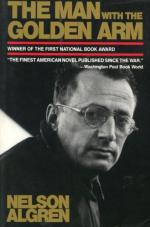|
This section contains 371 words (approx. 2 pages at 300 words per page) |

|
Algren's most abiding technique is simply that of classic realistic fiction — the graphic depiction of details of slum life, drug deals, card games, boxing rings, and all the other settings which represent the winner-loser environment: the dim barroom environment of the Tug & Maul; the grubby tenement shared by Frankie, Zosh, Molly 0, Violet and Old Husband; Nifty Louie's lair, where Frankie gets "fixed"; the station house in front of Captain Bednar's desk; the prison where Frankie does a stretch for stealing; and always, the streets, alleys, and doorsteps of Chicago.
Also important is Algren's surprising gift for dialogue, for capturing a particular kind of speech — fast talking, rapping, tall tales, and scams, represented in this novel by the ubiquitous chatter Frankie deals out with the cards. Indeed, Algren sets up his own mythology of urban life, complete with heroic characters, jargon, proverbs, and folk wisdom. But most...
|
This section contains 371 words (approx. 2 pages at 300 words per page) |

|




